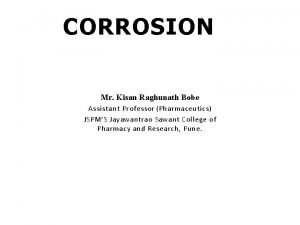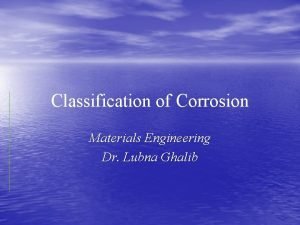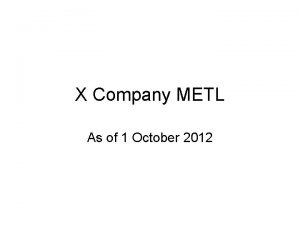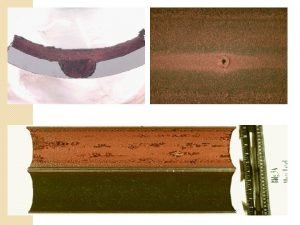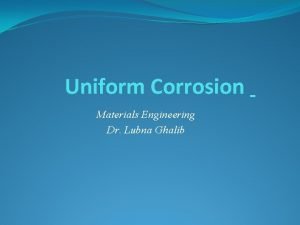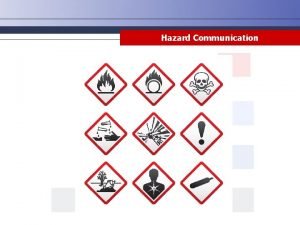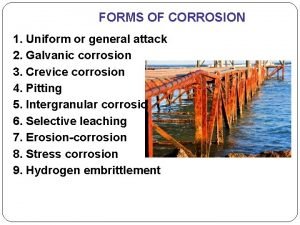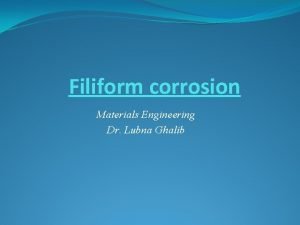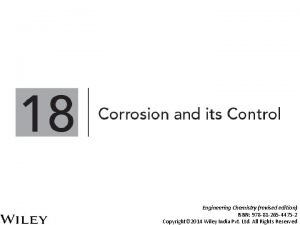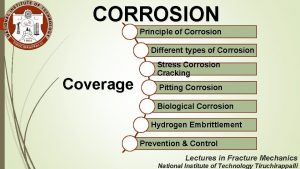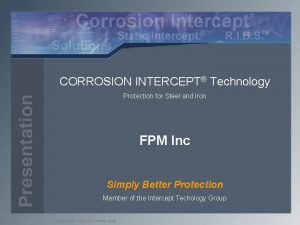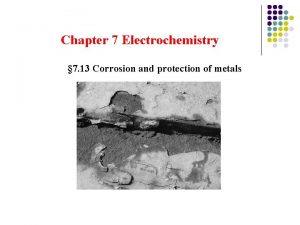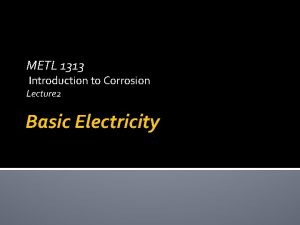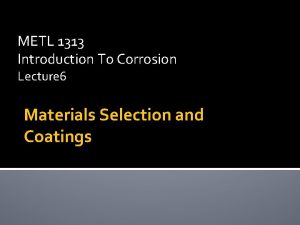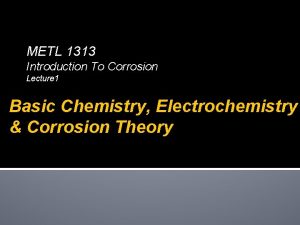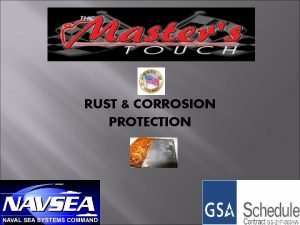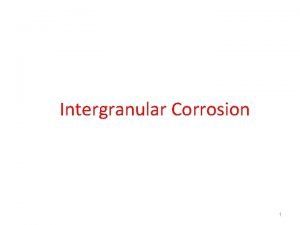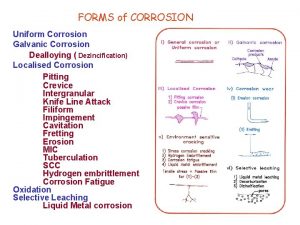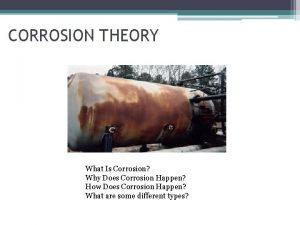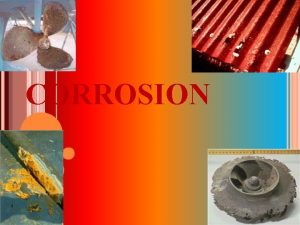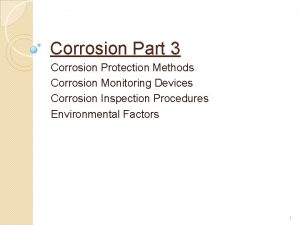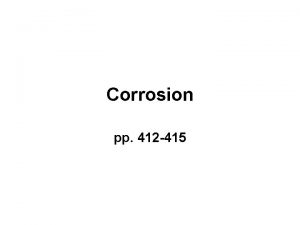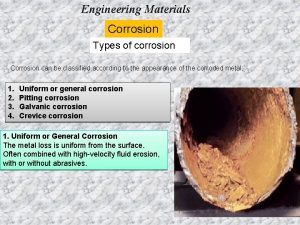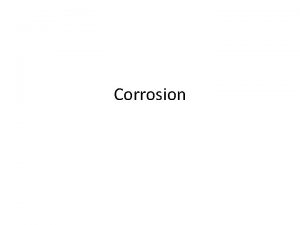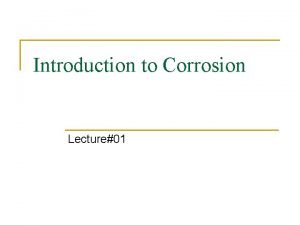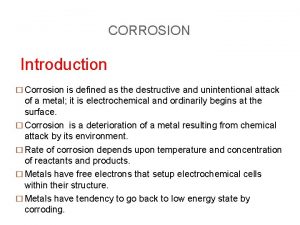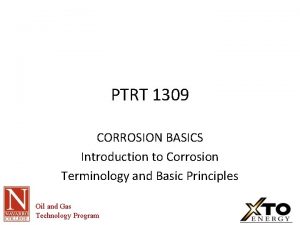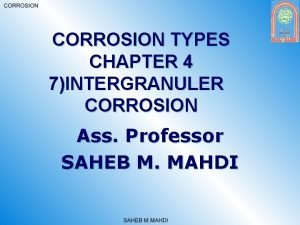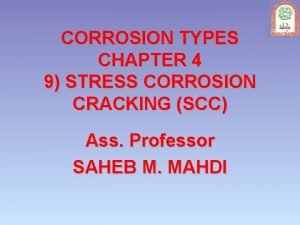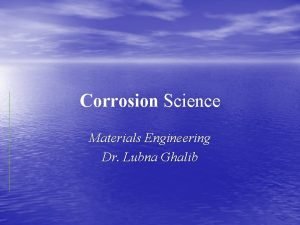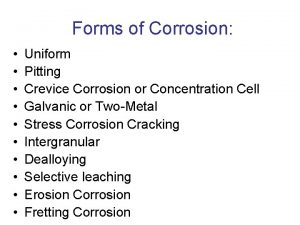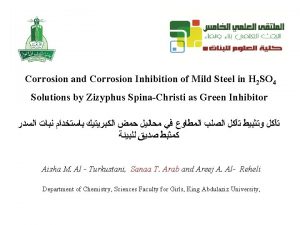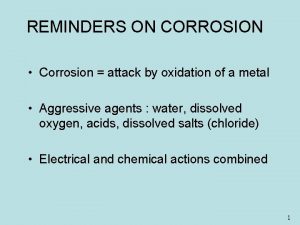METL 1313 Introduction To Corrosion Lecture 5 Corrosion























- Slides: 23

METL 1313 Introduction To Corrosion Lecture 5 Corrosion Fundamentals 1

Current Flow �One of the most important measurements in corrosion and cathodic protection is current. �Current in a corrosion cell is due to the flow of electrons, positive ions, and negative ions. �The corrosion industry, like most electrical measuring industries, has adopted the conventional current standard. 2

Current Flow �Conventional current is simply in the direction of positive charge flow. �In the electrolyte it is easy to see conventional current is in the same direction as the positive ion movement, from the anode to the cathode. �However, in the metallic path the only charge carriers are electrons, which are negative. 3

Current Flow �Conventional current flow is based on positive charge movement, the opposite of which is the direction of electron flow. �Therefore, the direction of conventional current in a corrosion cell is from the anode to cathode in the electrolytic path. �And from the cathode to the anode in the metallic path. 4

Current Flow �Understanding the direction of current flow is the key to understanding instrument connections and survey data. �Now that we understand what is happening in a corrosion cell. �The next question is what causes current in the first place. 5

Driving Voltage �As with any electrical circuit, current flow is due to a driving voltage or voltage difference. �Such as the voltage difference that exist between the anode and cathode of a corrosion cell. �The driving force of corrosion may be unleashed due to many circumstances. 6

Driving Voltage �Some of the most common circumstances that allow electrochemical voltages to be developed and drive corrosion cells are: �Heterogeneous makeup of metals �Variations between metals �Dissimilar metals (galvanic series) �Differential alloying makeup �Mechanical stresses �Temperature differences 7

Driving Voltage �Variations in the electrolyte near the metal surfaces �Dissimilar soils �Differential aeration (oxygen concentration) �Differential concentrations in ions, salts, or other chemical species �Bacteriology �Stray Current 8

Galvanic Series �The voltage differences between metals are due to the different levels of energy required in the refining process that each metal goes through to be converted from its natural ore to a useable metal. �The more energy required to refine a metal, the more active the metal is, and the higher its tendency to corrode. 9

EMF/Galvanic Series �A series that ranks the corrosion potential of pure metals under standard conditions is called the electromotive force series or EMF Series. �However, for this course we are going to explore the metals in what is known as a galvanic series, which is a more practical series that also contains alloys. 10

Galvanic Series �When any two dissimilar metals are connected together to form a corrosion cell. �The more active metal will be the anode and the more noble metal will be the cathode, under most conditions. 11

Alloying �In the alloying process, grain boundaries are formed. �Similar to dissimilar metals, the grain boundary may be more active or more noble than the adjacent metal causing a voltage difference. �In some instances the more active metal used to make an alloy may corrode, leaving behind the more noble metal. �The above is usually referred to as leaching, an example is the leaching of the more active metal zinc from an alloy such as brass. 12

Mechanical Stresses �When a metal experiences mechanical stress, the more highly stressed area is usually the more active area and becomes the anode of the corrosion cell. 13

Temperature Difference in Metal �If a metal is at different temperatures, the higher temperature area is usually the more active area and becomes the anode of the corrosion cell. 14

Dissimilar Soils �Dissimilar soils, such as clay and sand, due to their differences in resistivity (reciprocal of conductivity) and oxygen content, may provide the driving force for corrosion. �The metal in the vicinity of the lower resistivity soil is usually more active and thus the anode. 15

Differential Aeration �A metal exposed to different concentrations of oxygen may experience a difference in voltage. �The metal in vicinity of the more aerated or higher concentration of oxygen will be more noble or the cathode. �The reason for the above is that oxygen is a cathodic reactant. 16

Differential Concentrations �The higher the concentration of the same metal ions of a metal, that are adjacent to that metal, the more the noble the metal becomes. �For metal ions that are different from that of the adjacent metal, the effect may be difficult to determine. �When a simple salt is present that does not contain a metal ion, the area of the metal in the higher concentration of salt is usually the anode. 17

Temperature Differences in an Electrolyte �For temperature differences in an electrolyte, the area of metal in the higher temperature is usually the more active and becomes the anode of the corrosion cell. 18

Bacteriology �Colonies of bacteria can create conditions on the surface of underground structures which will cause more rapid corrosion by existing cells. �A significant type of bacteria is anaerobic which are bacteria that thrive in the absence of oxygen. �Bacteria themselves do not directly attack the metal, but intensify the existing corrosion cell by the food they consume and the products they produce. 19

Stray Current �Current flow through an electrolyte causes a voltage drop. �If a foreign structure passes through the path of current flow, then it will experience a voltage difference. 20

Corrosion Rate �We now know that a voltage differences cause current, and when current discharges from the metal to the electrolyte, corrosion results. �The detrimental effects caused by corrosion depends on the current density, the amount of current per unit of surface area. 21

Corrosion Rate �The factors that affect current density are complex and outside of the scope of this course, but are listed below: �Driving voltage �Surface areas of the anode and cathode �Polarization �Passivity �Cathodic protection involves polarization and will be discussed at a later time. 22

The end 23
 1313 kuhper
1313 kuhper Dry corrosion and wet corrosion
Dry corrosion and wet corrosion Dry corrosion and wet corrosion difference
Dry corrosion and wet corrosion difference Metl crosswalk
Metl crosswalk 01:640:244 lecture notes - lecture 15: plat, idah, farad
01:640:244 lecture notes - lecture 15: plat, idah, farad Introduction to biochemistry lecture notes
Introduction to biochemistry lecture notes Introduction to psychology lecture
Introduction to psychology lecture Introduction to algorithms lecture notes
Introduction to algorithms lecture notes Wet or electrochemical corrosion
Wet or electrochemical corrosion Uniform corrosion
Uniform corrosion Trenton corrosion protection
Trenton corrosion protection Corrosion under insulation primer
Corrosion under insulation primer Aluminium corrosion equation
Aluminium corrosion equation Skin corrosion symbol
Skin corrosion symbol Crevice corrosion
Crevice corrosion Filiform corrosion example
Filiform corrosion example Crystal dental fergus
Crystal dental fergus Galvanic corrosion
Galvanic corrosion Sulfidation corrosion
Sulfidation corrosion Oxidation in corrosion
Oxidation in corrosion Corrosion intercept bags
Corrosion intercept bags Corrosion coupon rack flow rate
Corrosion coupon rack flow rate Subsea erosion monitoring
Subsea erosion monitoring Waterline corrosion
Waterline corrosion

